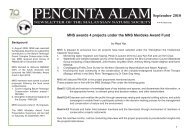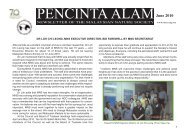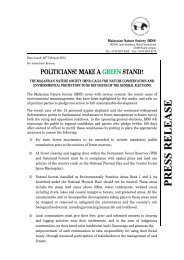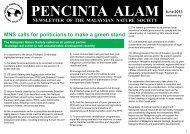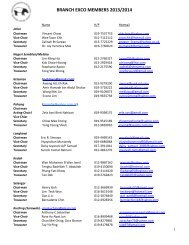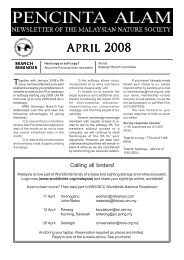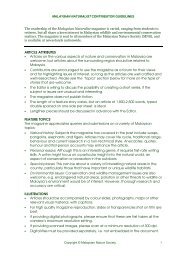PENCINTA ALAM - Malaysian Nature Society
PENCINTA ALAM - Malaysian Nature Society
PENCINTA ALAM - Malaysian Nature Society
Create successful ePaper yourself
Turn your PDF publications into a flip-book with our unique Google optimized e-Paper software.
Setting up a RafflesiaConservation Area for Researchand Education in PerakThreats surrounding Ulu GerohThe pressure of logging continues as theBukit Kinta Forest Reserve remains a production forestcategory under the Permanent Forest Reservesstatus.The removal of historical tin mining waterpipeline built in 1911, part of the tourist attractionand a national heritage.Action taken by MNS to dateUlu Geroh children photo session in front of theVisitor’s Information CentreRajah BrookeBirdwing butterflyin Ulu GerohAdvocacy - Since 2000, MNS has been advocatingfor the protection of the Rafflesia sites at the UluGroh Valley (size of approximately 3,500 ha). In2007, MNS proposed to the Perak Forestry Dept todeclare this unique natural heritage site as “RafflesiaConservation Area for Research and Education”.MNS has not received any positive response todate.Empowerment of local community - Between2002 -2008, MNS formed a group called SEMAI(Sahabat Ekopelancongan Memulihara Alam Indah)to be the stewards of the Rafflesia while earning anincome from ecotourism. A series of capacity buildingfor SEMAI members, establishing nature trails,setting up the Visitors Information Center, study visitsto other local communities, village awareness,children nature program, handicraft improvement,promotion and business networking.continues, page 4Ngah Teroq (guy on the right), licensed green badgeguide, showing tourists the Rafflesia bloom in UluGerohHighlights of Kampong (Kg) Ulu Geroh(UG), PerakHighlights of Gopeng (gateway to Kg UG)a. Gopeng town famed for its tin mining;b. Eu Yang Sang, herbalist started in this town;c. Kg Itek, home to the Rawa people from Indonesiawho came to work in the mines, became citizens andstill speaks their dialect;d. A historical century old tin mining water pipeline stillexists (partly removed recently despite protest).Kg Ulu Geroh, situated at the foothills of the Groh valley(within the Bukit Kinta Forest Reserve), is home tothe orang Semai, the largest group of orang asal in thePeninsular.Key Highlights of species found:a. 222 plants and 65 bird species recorded;b. 62 species of butterflies which include the RajahBrooke’s Birdwing Butterfly (largest butterfly inMalaysia);c. Home to the world largest flower Rafflesia cantleyi(endangered and endemic) and new colonies ofRafflesia documentedEcotourism activities that can be found within andsurrounding Kg Ulu Geroh:a. A choice of at least four trails to the Rafflesia sitesfrom Kg Ulu Geroh;b. Visit to the Rajah Brooke’s Birdwing Butterflycolony which is located near to the SEMAI VisitorInformation Centre;c. Home stay with the community can be arranged;d. Opportunity to experience the traditional sewingdance;e. For adventure seekers – a choice of abseiling, whitewaterrafting and caving;f. For serious trekkers, trek from Kg Ulu Geroh toCamerons can be arranged.2
A Bird’s Eye ViewAs I was volunteering myself at the MNSheadquarters at one fine day, I was briefed by Mayeabout the MNS Hornbill Volunteering program thatis held on an annual basis. My groupings were assignedto be on the 1st September to the 4th of September.Nevertheless, I was lucky enough as I wasjoined by three other SHELL employees who havenever joined this program previously as well.The first day began as we were gathered atKL Sentral. The ride to Banding wasn’t as bad as Ithought considering that it was a 5 hours journey.Once we were at the jetty, we were greeted warmlyby the head of the volunteering program, Terry, andher two orang asli guides. Then, we took the 45 minutesboat ride and headed to the village. The “pondok”that we stayed was so well organised and basicamenities were provided as well. It was pretty muchon briefings and ice-breakings among the volunteersbefore we called it a day.As we began our first hornbills count at7.00am, Terry was explaining to us on how to differentiatethe 10 species of hornbills that can befound in Temenggor. I was excited and trilled as Isaw a flock of the plain-pouched hornbills flyinggracefully from a distance. We were told that thehornbills were used to fly closer to the counting sitelast year. Unfortunately, due to excessive loggings,they have changed their flight path and thus countingthese unique birds would be harder. The amount ofbirds for that morning was about 24. My level of enthusiasmcame crashing down as the number of hornbillsthat was told by Terry was about 3000 last year.Hope began to enlighten me as the count hadincreased to 32 the next morning. It was an exhilaratingyet tiring day for us as we were brought by theorang asli guides to have a look at the wild rafflesiasin the forest. The group before us were lucky enoughas they had the chance to see the bloom ones whichcan be measured up to one metre in diameter! Then,we were brought to a nearby waterfall to freshen upourselves. Back in the village, we were taught onhow to prepare the “nasi buluh” by the orang aslithemselves. It was fascinating to learn their uniqueculture and to be a part of them was simply a rare experiencein each one of us.On the fourth day, we began clearing the surroundingarea of the village. Surprisingly, there wasloads of garbage found underneath the houses. Feelingreluctant to leave, we took our time to minglewith the orang asli and took pictures with them as aremembrance of our 4 days stay there. Once we hitthe Banding jetty, we headed back to KL and braced3
ourselves for the 5 hours journey thinking about theonce of a lifetime experience that we just had.- Anthony HowThis is the final update of a 4-part series. Atotal of 53 volunteers (2008: 34 volunteers) helpedMNS to monitor the Hornbills:Abdullah Fadilah, Angelina Chin ShukChien, Arifah Hassan, Aurelie Bosc, Bahriye Cagiran,Chan Bee Choo, Chew Lay Koon, Chew SinYie, Chia Lee Huang, Heah Gaik Yean, Heng KokBoon, Henson Quek Chung Thye, How Han Leong,James Lim Ted Huat, Joanne Ch’ng Sue Imm, KhooWei Sin, Kuan Chew Keong, Lee Li Chin, Lee LiLiang, Lim Joo Wee, Logeswary Shumugam, MohanadasNagappan, Mohd-Farihan Ibrahim, Ng EanSee, Ngew Siew Fong, Noor Syazlin Mohd Latif,Norhisham Mohd Ghani, Nurilda Hayati Misnan,Ong Hui Woon, Oo Choo Yee, Pasupathy, Patsy Mei-Tan, Peter Jones, Rajisware Coomarasamy, RangammalKalairajan, Samantha Lim Yi Cheng, SawalAwang, Seow Boon Eu, Shravan Rao, Sia SoekKiau, Siti Nor Hani, Tajul Arosh Baroky, Tan Chen-Kang, Tan Din Ding, Tan Hong Wai, Tan Jooi Chong,Tan Lian Hock, Tan Niah Sim, Teng Wei Khoon,Wang Min Yen, Yap Keng Teck, Yasin Abd Razakand Yong Kuan Yeoh.SHELL and Intel – thank you for allowingyour staff to take part in this conservation programme!On behalf of the volunteers and the <strong>Society</strong>,a note of thanks and appreciation to Terry and JessieOng. The “Ongs” in MNS has certainly made a differencein this year’s programme.Terry – Over the past 2 months, your passionin educating the volunteers and commitment to engagethe orang asli communities at Kampung Cuwehand Tebang has certainly contributed to a better volunteerprogramme.Jessie – Your patience in answering all thepossible enquiries!Dates in 2010 – MNS will upload the informationin this website next year. In the meantime, tolearn more about the hornbills in Temengor, logonto: http://hornbills.org- Maye Yaphttp://groups.yahoo.com/group/malaysiannaturesociety/Rafllesia, from page 2From 2008 onwards, SEMAI has receivedrecognition and is independently receiving funds forthe biodiversity conservation project from MENGO-Danida and SHELL for local indigenous communityprojects.Ongoing surveys of Rafflesia sites in the valleywill be done and MNS will assist in documentingthe report and presenting to the Government of Perakto re-gazette the production forest status to watercatchment/ scientific status for the Permanent ForestReserve.Mobilising members and supporters – This projectis made possible as we had active MNS memberssuch as Cheaw Hon Ming, Neal Nirmal, DonnaBaylis, Prof Kamarudin and Prof K Fletcher to lendtheir expertise. Corporate supporters such as CIMB,Dow Chemicals and HSBC provided funds to enableMNS to continue with the conservation work in UluGeroh, Perak.Keen to supporting ongoing conservation initiativesin Ulu Geroh? Donation above RM50 to<strong>Malaysian</strong> <strong>Nature</strong> <strong>Society</strong> under Ulu Geroh ConservationInitiatives and you will receive CD version ofthe Ulu Geroh – The Big Flower, The Butterfly andthe Semai and postcards by Fletcher and Baylis.For more information email Maye Yap athod.services@mns.org.my4
Eco KidsReusing laminated paperMany of you have developed the good habitof recycling paper at home and in school, but are youaware that wax-coated paper (including paper cups),foil-coated paper and laminated paper cannot be recycled?The best thing to do is always to try to reducethe need to laminate paper. You could try to put paperin transparent plastic folders instead, and reuse thefolders many times over. However, you can oftenfind discarded laminated paper left behind after anoutdoor event. People use laminated paper to makesigns and event announcements. Once the informationbecomes outdated, the laminated signs are leftbehind. It seems such a pity to have to throw themaway. Here are some ideas as to what you could dowith unwanted laminated paper:1. Make your own notebooks using once-usedpaper, and use the laminated paper as covers foryour notebooks.2. Line boxes, drawers and cabinets with laminatedpaper to protect the furniture surfaces from beingscratched or dirtied.3. Use the laminated paper as placemats for thedining table, and as craft mats for messy artprojects.4. If the reverse side of the laminated paper is whiteor blank, use that surface as a writing board. Youcan write on it with a whiteboard marker. Use asmall rag or piece of sponge as a whiteboarderaser.5. Cut the laminated paper into broad strips and usethem as bookmarks.6. Cut the laminated paper into thin, long strips anduse them as a weaving material. Weave a squareor rectangular base for a basket, crease and foldthe ends of the strips upwards to form a 'wall',and weave other strips into these. Glue, staple ortape the ends into place. If stapling, cover thesharp ends of the staple with a strip of masking orduct tape so no-one gets injured.7. Make them into trays or boxes. Use a ruler todraw lines on all four sides of each sheet. Cut theline where two sides meet. Fold and crease thesides up so you form four 'walls' for the tray. Glue,staple or tape the sides into place. If stapling, coverthe sharp ends of the staple with a strip ofmasking or duct tape so no-one gets cut. To makea lid, make the sides 2-3 mm narrower, so the inside surface will be wider and longer than the traythat is intended as the bottom half.Uses for the trays/boxes:- For sorting and storing Lego, beads and art materials.- To hold keys and pens on tables and desks- As drawer dividers and sorting trays for socks andsmall items.- To hold nutshells in before transporting them outto the compost heap.- As coasters for your mug, where you can pile biscuitsin the extra space on your coaster/tray.There's always new uses for old and unwanted itemsas long as you put your mind to it!- Wong Ee Lynngl.mnselangor@yahoo.comRethink move to introduce alienfish species in Kenyir LakeThe <strong>Malaysian</strong> <strong>Nature</strong> <strong>Society</strong> (MNS) views withdeep concern on the report that the Mekong Giant Catfish Pangasianodongigas will be introduced to the Kenyir Lake in HuluTerengganu as part of the state’s lake replenishment efforts.Kenyir Lake, known as the largest man-made lake inSouth-east Asia covers a vast 260km2 and is a water reservoirfor most states. With a water catchment area of 38,000 ha, thelake is known to host nearly 300 species of freshwater fishes,which includes the Lampam Sungai, Kelah, Toman, Kalui, Kelisa,and others. These native fish are currently threatened withextinction due to overfishing and habitat destruction and degradation.Thus, any initiative to replenish our lakes and riversshould focus on conserving and restoring the populations ofthese native fish species rather than importing or introducingalien fish species such as the Giant Mekong Catfish.Alien species can turn invasive due to the absence ofits native predator in its introduced environment, which willthen negatively impact the local flora/wildlife. Based on the recentMillennium Ecosystem Assessment (2005), (invasive)alien species has been identified as one of the key drivers ofbiodiversity extinction. Globally, various cases have been doccontinues,page 145
Green Living ColumnReducing paper wastagein the officeFACTS ABOUT PAPER USE AND WASTAGE:1. The average office worker uses 10,000 sheets of copypaper each year.2. Over 40% of wood pulp produced in the world goestowards the production of paper.3. The costs of using paper (i.e. printing, copying, faxing)can run 13-31 times the cost of purchasing the paperin the first place!4. It takes more than 1 ½ cups of water to produce 1 sheetof paper (Picture a typical soft drink can).5. Reducing paper use reduces greenhouse gases. 40reams of paper is equivalent to 1.5 acres of pine forestabsorbing carbon dioxide for one year!6. Even with recycling efforts, paper makes upapproximately 25% of the waste we throw away. Weare still throwing away a lot of resources!WAYS TO REDUCE PAPER WASTAGE:1. Always make double-sided copies.2. Set computer defaults to print double-sided.3. Reuse paper printed only on one side in the faxmachine, for draft copies and for internal documents.4. Preview documents before printing. Use the printpreview to spot formatting errors and blank pages.Proofread first and use the grammar & spellcheck toavoid errors that will cause documents to be reprinted.5. Save emails, minutes and other documents onto harddisk. Delete margins, duplicates, contact details, logos,footers and anything unnecessary, and resize and realign the font and paragraphs to take up the least spacepossible. It makes for easier reading and if the need toprint it arises, less paper will be used.6. Promote a "think before you copy" attitude. Considersharing some documents with co-workers. Print onlythe number of copies needed for the meeting, don'tmake extras.7. Print or photocopy only the pages you need, and onlythe number of copies you need. There is no need tomake extra copies for standby. If it is in the disk, it canbe reprinted as and only when needed.8. Save a copy of important documents into your harddisk or e-mail folders. Create folders to keep everything organised and retrievable. Fix a date every monthto review the folders and delete documents you nolonger need.9. Saving documents on soft copy may even make yourlife easier! You can just copy and paste fromdocuments, than refer to the printed copy and typeeverything from scratch again.10. However: Don’t be a pack rat and save everything todisk, especially when the information is readilyavailable elsewhere! Keep your inbox and hard disktidy and organised. This will save memory/disk spaceand prevent the need to purchase additional diskstorage or thumb drives.11. Examine the reports and documents you printregularly to see if people still need them. Many times,they are created for someone who has left or who doesnot need it anymore.12. Remove printers from desks and move them to acentral location where one printer will suffice formany people. This will reduce wasteful printing aspeople will decide it is too much hassle to printunnecessary and personal items.13. Have an inter-departmental competition to see whichdept uses the least paper. Give each Dept a fixednumber of reams of paper a week, and mark thepackaging, e.g. with Dept X #1, #2 and so forth foreach ream. At the end of each week, reward the deptthat has the most unused reams of paper remaining. Ofcourse, you will need to take into account the fact thatsome office departments, say, the Legal Dept, willneed to use more paper than the others.14. Impose a fine on those found to be wasting paper,e.g. crumpling up once-used paper and tossing it intotheir wastepaper basket when they should be puttingit back into the printer tray for drafts. Even crumpledpaper can be reused as memo pads.15. Give members/subscribers/customers/clients theoption of going paperless and of receivingnewsletters, correspondence, catalogues and otherdocuments via email. Of course, this is not possiblewhere there are legal issues, e.g. acceptance ofcontract, admission of liability etc, so in thoseinstances, resize and reformat before printing andprint on both sides if you can. If a hard copy is goingto be sent to you, then don’t print out the email.16. Unplug the fax machine and request that the sendingparty email instead. That way, you have morecontrol over whether something should be printed,and you can resize and reformat it before printing.This will also eliminate junk mail by fax. At least tryto unplug the fax machine after official office hours.17. Keep copiers and printers in good repair and make itpolicy to only buy copiers and printers that make reliable double-sided copies. Let your copiermaintenance person know when a copier isperforming poorly (toner is low, jams frequently, etc.).Regular copier maintenance is important, especiallyif the toner is low. Copiers are often used until all thetoner is gone and that wears down machines. A copierthat works well is less likely to jam and this helps savepaper.- Wong Ee Lynn, gl.mnselangor@yahoo.comTopic proposed by Ling Mee Hong6
BookshelfPrice: Member RM 126.00,Non-member RM 140.00Speleological ExpeditionGunung Lanno MalaysiaEdited: Ernest Geyer et alPublisher: Liz PriceYear Published: 2005Type of Cover: Hard coverNo. of pages: 240This report unveils the results of a speleologicalexpedition held in November 2001 under the leadof the “Verein fur Hohlenkunde in Obersteier” inthe Kinta Valley, Peninsular Malaysia.The target was the caves in GunungLanno, an isolated limestone mountain denselyovergrown with primary forest. The team workedsystematically in three groups. During threeweeks, 32 caves were documented and 12 kilometresof passages surveyed. Four temple caveswere also surveyed during the expedition. Thebiggest discovery was one of western Malaysia’slargest chambers, the “lanno Summit Chamber”.60 meters wide and more than 180 metres long,located directly below the peak of the mountain.Many invertebrates were collected in the caves,most of them could be determined. Several newspecies were discovered.Language: Bilingual in German and English.Price: Member RM 120.00,Non-member RM 108.00Limestone Hills & Cavesof the Kinta ValleyAuthor: S. L. Wong andCheang Kum SengPublisher: <strong>Malaysian</strong><strong>Nature</strong> <strong>Society</strong>Year Published: 2009Type of Cover: Hard coverNo. of pages: 149Famed for their beauty and exploited in numerousways, the limestone hills and caves of the Kinta Valleyare amazing repositories of the past, both naturalas well as human. This book is a tribute to that rarebeauty and a call for responsibility as custodians ofour precious heritage.About the authorsCheang Kum Seng is a retired Maybank-erwho has found a second career in professional industrialand commercial photography. His passion,though, is nature photography. His images have appearedin numerous magazines, newspapers andbooks, and were used for many in the stunning coverimages of the <strong>Malaysian</strong> <strong>Nature</strong> <strong>Society</strong>’s Naturalistbetween 1995 and 2000. Trough his need to photographand study birds, he co-discovered the use ofcompact digicameras with sighting scopes and inventeddigiscoping adapters to allow close-up photographsof birds and wildlife; this is now knownthroughout the birding world as ‘digiscoping’.Cheang is an Associate of the Royal Photography<strong>Society</strong> of Great Britain (ARPS); Honorable Fellowof the Photographic <strong>Society</strong> of Penang,Malaysia (Hon.FPSP); Honorable Fellow of thePhotographic <strong>Society</strong> of Alor Star, Malaysia(Hon.FPSA); Honorable Fellow of the Foto ImagePerak, Malaysia (Hon.FPIP); member of the<strong>Malaysian</strong> <strong>Nature</strong> <strong>Society</strong> since 1992 and memberof the <strong>Malaysian</strong> Karst <strong>Society</strong> since 2002.S.L.Wong is an Ipoh-born freelance writerwho specializes in environmental and travel writing.Her work appears in the print, broadcast andelectronic media both in Malaysia and overseas.She has authored, edited and contributed to 24books, including conservation-based natural historybooks on Perlis, Belum, Matang, Langkawi,and Terengganu.Books are available at ‘The MNS Shop’T/F: 03-22873471.E: natureowlet@yahoo.comPlease call/e-mail before dropping in.http://groups.yahoo.com/group/malaysiannaturesociety/8
Calendar of ActivitiesOctoberTBCMeeting: Plight of the HawksbillTurtle In conjunction with WWF-Malaysia and the Renaissance Hotel, Melaka, theNegeri Sembilan/Melaka Branch is organising anOpen Meeting to discuss the plight of the HawksbillTurtles’ breeding ground and activities on PulauUpeh, close to the coast of Melaka.Following the approval of a tourist developmenton Pulau Upeh, an Environmental ImpactAwareness Report is to be carried out before the startof any development.The purpose of the meeting is to enlighten allabout these precious creatures and the need to preservetheir unique breeding grounds in this part ofthe world.Details, including date, will be announced onthe branch website at http://www.mns.my/secstate.php?sid=2&stid=5For further details, contact Stephanie Bacon(012 2175590, cooltek@streamyx.com) or LimMing Hui (012-2760327, limmel05@yahoo.com)3Sat Guided Walking Tour: Rimba Ilmu Thismonthly walk around the botanical gardens atRimba Ilmu looks at the collections in the gardenswhile discussing environmental and ecological issues.It includes a visit to the Rainforest Exhibitionand the Rare Plants Conservatory. Led by AngelaHijjas (who can be reached only in emergency on012 210 4229) it is an easy and informative walk ofinterest to anyone concerned about biodiversity andconservation. Open to the public, a charge of RM4per adult, half for children, will be charged for thejoint Universiti Malaya/MNS Environmental EducationFund. Meet at the steps of the main building (directionscan be seen at the main entrances to thecampus) at 9AM, wear long sleeves and white if youare susceptible to mosquitoes.6Tues Talk: ”Injuries to Wild Birds” MNS HQAuditorium at 8pm.Do you know that there is an animal hospitalin Universiti Putra Malaysia (UPM)? Various animals,including birds, are sent there for treatment andrehabilitation. Dr Jalila bt Abu, a senior lecturer withthe Faculty of Veterinary Medicine, UPM, will sharewith us how the hospital handles injured wild birds,from diagnosis to the release process.Admission is FOC. All are welcome (includingnon-members). Contact: Lim Wai Kong (012-3935189, drwklim@yahoo.com)10Sat Photo Outing: Sg Chilling (Kuala KubuBaru) Meeting time: 7:00 am. Meet up point:Mamak / indian makan shop diagonally across postoffice.It is a day trip along and across Sg Chillingfor a photography session to capture the beauty ofSg Chilling and waterfall. Please be prepared to getwet as there are 6 river-crossings. Adidas kampungshoes /dive-booties/hiking shoes are better optionthan sandals.Bring along own drinking water and packedlunch (no pork please and no styrofoam or any nonenvironment-friendlydisposables), change ofclothes, waterproof plastic (for the camera), tripod,brolly/raincoat, trekking pole,and most important,camera and a happy self.Please sms/call Tovee at 012-3887498 oremail toveewan@gmail.com your interest to join.16-21Fri-Wed Raptor Watch: Radar Hill,ThailandThailand serves as a crucial land-bridge forconnecting raptors breeding in the northern hemispherewith overwintering areas in the south likeMalaysia and to the far east.Radar Hill, near Chumphon, is one of thebest spots in Thailand to observe raptors in migration,offering views at or near eye-level and oftenraptors are seen passing below the watch site as well.Participants will take a midnight express buson Oct 16th from KL to Hatyai where they will takea connecting van to Radar Hill. Return will be byovernight train from Chumphon to Hatyai, then expressbus back to KL.Contact Alan Yu at 016-3322991 oralanyu01@gmail.com for payment details. P r e -trip meeting on Thursday, 8th Oct 2009, 8pm at MNSHQ Auditorium.21Wed Photo Meet: Macro photography (Apractical shoot) MNS HQ auditorium from8pm to 10pm.MNS Photogroup will be having a sharingand discussion of interest and tips on macro photography.Members who are interested in learning and9
efining their skills in macro photography are encourageto come for the session. Macro photographyis an up close technique in capturing the beauty ofmother nature's creation, amongst others.Please bring along your camera (compulsory)for the practical session of photography. Allcameras are welcome (compact / SLR, film / digital).Amongst other accessories to bring are tripodand flash, if any. We will be setting out some smallflowers as prop for members to experiment in macrophotography. As we are conducting the practical indoor,flash is required. So bring yours along.MNS Photogroup usually has its monthlymeet up every 3rd Wednesday of the month. MNSmembers are invited to join the meet up for a sessionof sharing and discussion. If you have any photos toshare, feel free to show the members during the meetup. However, the session will be limited to 10 photosper member, depending on the time factor.Please contact kokyoonlee@gmail.com orAlex Foong afoong@tm.net.my for more information.Sat Visit to United Plantations Jendarata24 Estate, Teluk Intan, PerakThis oil palm plantation is a model of sustainableagricultural practice, and is the first plantationunit to achieve certification for sustainabilityunder the certification system of the Roundtable onSustainable Palm Oil (RSPO). It is an impressive exampleof how conservation, people and business interestscan harmoniously coexist. The programmewill include guided visits to the production fields, theprocessing mill, the R&D complex, bakery, biogasplant and wildlife sanctuaries within and managedby the estate. A complimentary lunch and tea is includedfor participants.Time: 6.30 am. For further information andto book a place (limited to 25 pax) please contactJutta (Flora SIG Coordinator), waldelf@gmail.comRegistration is at first-come-first-served. Apre-trip meeting will be announced in early October.25Sun Taiping Raptor Watch 2009 Scott’s Hill,Taiping, from 0900 hrs to 1300 hrs.The geographical location of the MalayPeninsula at the tip of continental Asia is significantfor migrating raptors. This tongue-like slice of landacts as a migration take-off point from mainland Asiato the islands of the Indonesian archipelago.During spring, raptors leave their winteringareas in Indonesia and fly along the Malay Peninsulato head north to their breeding grounds in northernAsia. In autumn, they make the return passage andhead south, flying along the Malay Peninsula to winteringgrounds in Indonesia.Thanks to the popularity of the Raptor WatchWeek programme organized by MNS at TanjungTuan, Melaka, the general public is now more awareof the phenomenon of raptor migration. Everyspring, raptors fly back from wintering areas inSumatra and cross the Straits of Malacca to TanjungTuan and continue northward. During Raptor WatchWeek, participants get to experience the awesomesight of raptors flying in low overhead after the dangerouscrossing of the Straits of Malacca.Located at the foothills of the Larut Range,Taiping lies on the flyway of migrating raptors asthey pass along the Perak coastal plains. During the10
autumn months of September to November, thousandsof raptors have been recorded passing overTaiping.To date, 16 species of migratory raptors havebeen observed on passage, with the highest seasonalcount of 42,000 recorded in 2003. Last year, thecount was 19,000. The Bird Group of MNS PerakBranch has been organizing an annual raptor watchat Scott’s Hill in Taiping since 2003. Unlike RWW,the Taiping Raptor Watch is not organized for masspublic appeal as the site is small and located on privategrounds.Participants are to meet at the foot of Scott’sHill (see map below for directions) at 9.00 a.m. Fromthere, it is a short uphill walk to the observation site.Wear light clothes and hat. Bring along binoculars,water, snacks and umbrella for protection from thesun. You may also want to bring a chair or groundsheetto sit on while waiting for the raptors to turnup.Co-ordinators: Lim Kim Chye & Lim SweeYian (h/ph 016-553 8431, 016-422 3895). For moreinformation on raptor migration, please visit theAsian Raptor Research & Conservation Networkwebsite at http://www5b.biglobe.ne.jp/~raptorAll events, times and venues are correct at timeof printing. For latest updates, contact yourfavourite SIG, check the MNS website regularlyor join the eGroup by sending an e-mail tomnselangor-subscribe@yahoogroups.comDon’t Leave Home Without ItAll members are required to show their membershipcards to participate in any of theBranch’s activities. New members who haven'treceived their cards will be required to showtheir membership payment receipts. Lost yourcard? Contact Wee Chin at HQ.Do you know that all our Assets including banks’ accounts will be frozened upon Death? With OR Without a WILL!!How do you “unlock” them? A Grant of Probate or Letter of Administration from the High Court. This process appliesto Muslims and Non Muslims.If you pass on without having a VALID WILL….this is what happens…..1. Your Family Your spouse and children will face cash flow problem because all your bank accounts including joint accountswill be frozen Your children’s welfare may not be taken care of by the people of your choice2. The legal Process Delay in distribution due to the legal administrative process (2 - 6 years) 2 guarantors / sureties required (amount equal or more than deceased’s estate) Much more costly resulting in financial burdens to your family3. Your Asset Distribution (As per Distribution Act 1958 amended in 1997) or (Distribution under Faraid) The law will decide on the distribution of your estate such as house (s), Businesses, bank accounts, shares, etc.LOVE YOUR FAMILY, WRITE YOUR WILL TODAY AND ENJOY A PEACE OF MIND wherever you maybe… Travelling,Trekking, Caving, Mountai n Climbing, Diving, Biking, Camping, etc.Why leave to chance….for more information, please call……http://groups.yahoo.com/group/malaysiannaturesociety/MARY OOIProfessional Estate Planner (Rockwills Corporation Sdn. Bhd.)Islamic Estate Planner (as-Salihin Trustee Sdn. Bhd.)H/P: 012-3379906 or email: mary_3_ooi@hotmail.com11
November715Sat Guided Walking Tour: Rimba Ilmu Pls refer to October 3rd writeup.Sun Half Day Bird-Watching Trip: Genting HighlandsThe Selangor Bird Group is organizing a half-day bird-watchingtrip in the sub-montane area known as the old pumphouse road, near Awana.The group will be meeting at the gates leading to the old pumphouse road (next to the roundabout after the township of Goh Tong Jaya.Bring your own binoculars if you have a pair. Wear dull-colouredclothes, hat and comfortable shoes. Mosquito repellent will also come inuseful. Bring along a jacket as it may be chilly early in the morning. Theevent will end before noon.Those interested please contact Mr Tang at 012-3061133 or MrMark Ng at 012-3195189 (call between 6.00pm and 10.00pm) or emaildaytrips@piedfantail.com.(742912-V)Website: http://www.mymountaingoal.comContact : Thong at goalus@mymountaingoal.comTel/Fax : 03-6275 4913Annapurna Circuit trek from 29/10/09 to 13/11/09Duration: 16 daysMaximum Elevation: 5416mGrade: Medium / HardSeason: Mid September toNovember and March to midMayWalk completely around the Annapurna massif. Trek through low land Brahminand Chhettri villages to the remote Manang village, and down the KalkigandakiGorge (officially deepest George in the World). Cross a 5416m pass-probably thehighest you will ever get without climbing a mountain.Two free training trip will provided for the trip.Further info:- http://www.mymountaingoal.com/AnnapurnaRegion.htmMaliau Basin “Lost World of Sabah,borneo.” From 20/11/09 to 24/11/09Questions for CouncilThe next meeting of the MNS Councilis scheduled for Saturday, 24 October 2009.Members who wish to raise issues for discussionat Council, please contact your Branchchair (emails are listed at back of this newsletter)or MNS Honorary Secretary, Jessie Cheahat jessie1303@gmail.com Agenda items mustbe submitted at least two weeks prior to theCouncil meeting for inclusionThe Maliau Basin is one of the most spectacular and pristine natural featuresin Malaysia, and indeed, Southeast Asia. The Maliau Basin is almost unvisited andcompletely uninhabited by man.While all of this region is rugged, remote and forested, the Maliau Basin isdistinguished by its steep slopes up to 1,500m in height, making it insurmountable onfoot from most directions. The size of the enclosed Basin is 390 sq. km with a maximumdiameter of 25km. The highest point Mt. Lotung, on the north rim stands at1900m. It is drained by a set of radiating tributaries of the Maliau River, one of whichdescends a series of waterfalls, known as the Maliau Falls.Further info:- http://www.mymountaingoal.com/maliaubasin.htm12
MNS HQJKR 541, Jalan Kelantan,Bukit Persekutuan, 50480 Kuala Lumpur(just before the Seri Perdana turn-off onJalan Mahameru). M-F 9am-5:30pm.T: 03-22879422. F: 03-22878773.mns@mns.org.my www.mns.org.myMembership: Leong Wee ChinJOHOR BRANCHc/o Prof. Madya Dr. Maketab Mohamed,No. 90, Jalan Pulai 50,Taman Pulai Utama, 83100 Johor Bahru.www.mnsj.org.myChair Prof Madya Dr. Maketab Mohd019-3519866,maketab_mohamed@yahoo.comVice Chairman Dr. Lum Wei Wah019-7838388, blumww@gmail.comSecretary Zalinah Sarpan, 013-7722229Zalinah.sarpan@my.lafarge.comTreasurer Chern Boon Hong012-7800023KEDAH BRANCH289, Tingkat Bawah, Jln Shahab 1, ShahabPerdana, 05400 Alor Star, Kedah.Chairman Kalaimani a/l Supramaniam019-4733505, maniria@yahoo.comVice Chair Tengku Badrillah b T. Abdullah019-4150090, tbadril@hotmail.comSecretary Phang Fatt Khow012-3116420, fkphang05@yahoo.comTreasurer Tan Dek019-5762823, tandek07@yahoo.comKELANTAN BRANCH204, Jln Sultan Yahya Petra,15150 KotaBharu, Kelantan. shown@tm.net.myChairman Tan Kee Leong, Michael012-9538858, mike1958@streamyx.comVice Chair Pauzi bin Husin019-9556477, stongpark@gmail.comSecretary Wong Mei Linmeklawa@gmail.comTreasurer Evone Limevone2meng@yahoo.comLANGKAWI BRANCH (pro-tem comm)Chair Irshad Mobarak012-5846184, junglewalla@gmail.comVice Chair Anthony Wong019-3398056,anthony@asianoverland.com.mySecretary Teoh Cheng Kung013-4881013, wildlifeplanet@gmail.comTreasurer Wendy Chin Yoon Mun012-5952906, wchinner@yahoo.comNEGERI SEMBILAN/MELAKA BRANCHc/o Cooltek, 350 Jln Woodland,Tiara Melaka Golf & Country Club,Ayer Keroh, 75450 MelakaChairman Lim Ming Hui012-2760327, limmel05@yahoo.comVice Chair Kok Chow HioongSecretary Stephanie Bacon012-2175590, cooltek@streamyx.comTreasurer Lee Ah Geok016-6041275, ahgeoklee@hotmail.comPAHANG BRANCHF-4-4, Jalan Padang Golf,25050 Kuantan. mnspahang@yahoo.comChairman Datin Narimah bt Daud012-7205383, dnarimah@yahoo.comVice Chair Noor Jehan bt. Abu Bakar019-9525588,versed_anggerik@yahoo.comSecretary Chow Mee Foong 0199515169chowmeefoong@yahoo.comTreasurer Ho Chin Leong019-9693997, hcl34823aia@yahoo.comPENANG BRANCH<strong>Nature</strong> Information Centre (NIC),673-B Jalan Kebun Bunga,10350 Penang. T/F: 04 2273673.Open Mon-Sat, 7.30am - 11.30am (Pleasephone before visiting).www.geocities.com/mnspenang/Chairman Kanda Kumar04-2273673, kandakum@tm.net.myVice Chairman Hymeir Kamarudin019-4428926, hymeir@gmail.comSecretary Lai Ee May 012-5385642,eemaylai@yahoo.comTreasurer Foong Swee Yeok012-5529694, foong_sy@yahoo.comPERAK BRANCHPO Box 34, Ipoh Garden Post Office,31407 Ipoh.Chairman Leow Kon Fah 019-5634598,leow_kingfisher@yahoo.comVice Chair Lee Ping Kong016-5655682, lpk682@yahoo.comSecretary Tham Yim Fong012-5220268, georgi8tham@yahoo.comTreasurer Har Wai Ming019-5724113, wm.har@klk.com.mySABAH BRANCHLot F-4-18, Block F, 4th Floor,Plaza Tanjung Aru, Jln Mat Salleh,Tanjung Aru, 88100 Kota Kinabalu.mns_sabah@yahoo.com.sgChairperson Anna Wong016-8346808, anna888@ums.edu.myVice Chair Omar Abdul Kadir019-8110125, omar_kadir51@yahoo.comSecretary Maria Joy Rowan019-5348772,mariajoyrowan@yahoo.co.ukTreasurer Muhammad Ali Syed Hussein016-2398111, tilan@yahoo.comSARAWAK (KUCHING) BRANCHmnskuching@gmail.comChairman Rebecca Jothi D’Cruz019-8579110, dcruz.rebecca@gmail.comVice Chair Cheong Ah Kwan019-8349499, kwan_indutek@hotmail.comSecretary Chan Mei Ching, Zora Sharon019-8279881, zorachan76@yahoo.comTreasurer Jacinta Wong-Schneider012-8862911, jwsgmgs@streamyx.comSARAWAK (MIRI) BRANCHc/o EPA-T-DGP, Sarawak Shell Bhd,Jalan Pantai, 98100 Lutong.mnsmiri@yahoo.comChairman Nazeri Abghani085-453185, mnsmiri@yahoo.comVice Chair Sara Wong Ching Tai012-8786100, sara.wong@curtin.edu.mySecretary Grace Siew Yee Len085-452585Treasurer Amer Matridi Abu Mansur Matridi012-6259121, a.a.abumansurmatridi@shell.comSELANGOR BRANCHc/o MNS HQ addresswww.mns.org.my/selangormns.selangor@gmail.comChairman Gary Phong013-3836288, garyphong@netscape.netVice Chairman James Cheriantansencherian@yahoo.comSecretary Gan Li Li012-2074840, pat_ganll@hotmail.comTreasurer Bernadette Chin012-6928356, berniechin118@gmail.comTERENGGANU BRANCH1926 Bukit Kubang Jambu,20050 Kuala Terengganu.mnsterengganu@gmail.comChairman Hj Wan Md Adnan017-9861926, wadnan@streamyx.comVice Chair Anuar Abd McAfee017-9864177, anuar@ms.kusza.edu.mySecretary Dr Chong Ju Lianjulianchong78@gmail.comTreasurer Wee Seng Whatt019-9363828, swwee@pc.jaring.my13
Alien fish species, from page 5umented where introduced fishes causedthe extirpation of native endemic speciesand habitat alterations. Has the TerengganuState Government conducted a thoroughstudy to identify potential impacts of theintroduction of the Mekong Giant Catfishinto Kenyir Lake and its native fish fauna?Efforts in Indochina and Thailand, wherethe species originate from, have alsoshown that the species does not breed wellin enclosed water bodies such as ponds andlakes. This would mean that the StateGovernment would have to keep spendingmoney to restock the lake which wouldincur a high cost over time.Although the Mekong Giant Catfishis listed in the IUCN Red List 2008 ascritically endangered and calls for captivebreeding as one of its conservation actions,introducing the fish into Kenyir Lake in theattempt to ‘assist’ its conservation is misguided.Any reintroduction must be doneat the catfish’s distribution range, of whichMalaysia is not. Additionally, this speciesis listed under Appendix I of CITES, whicheffectively prevents any trade of the animal,thus raising the question on wherethese catfish stocks will be coming from.While MNS lauds the efforts toreplenish fish populations in Kenyir Lake,we strongly urge the State Government torethink this idea and to focus on native fishspecies to further help conserve our country’sfreshwater biodiversity. Globally,many countries are fighting hard to eradicatealien species within their shores andtheir efforts have proved to be costly financially.In light of these past experiencesand lesson learnt in battling invasive alienspecies, introducing the Mekong GiantCatfish into Kenyir Lake is entirely unwiseand potentially harmful.MNS LibraryA modest collection of books and periodicals is housed at the MNS Headquarters. Only fully paid up members may borrow books for a periodof two weeks. This period is renewable. Periodicals are for use only in the library. Readers wishing periodical articles may have them photocopied.A small, but growing collection of books for young readers is also available.Pencinta Alam is a monthly newsletter made possible by dedicated volunteers and contributors from the <strong>Malaysian</strong> <strong>Nature</strong> <strong>Society</strong>.Accuracy is the contributor’s responsibility. The Editor reserves the right to edit for length and content.Submissions: Articles including the author and photographers’ names (max. 500 words), advertisements, digital images (100 dpi & no largerthan 640x480 pixels & separately from article), etc. must reach the Editor by the 13th of each month (unless noted otherwise) via the followinge-mail address: tapir2005@gmail.com.Advertising rates: Classifieds: RM5 per column inch. Quarter page ad: RM30. Half page ad: RM60. All payments must be made to “<strong>Malaysian</strong><strong>Nature</strong> <strong>Society</strong> Selangor Branch”. Please bank in cash or cheque to Maybank MBB account no 014150307352. After banking in, please scanthe slip and e-mail it to Bernadette Chin at berniechin118@yahoo.com or fax her at 03-51928191 (Attention: Bernie Finance).Discount Rate for ads paid in advance: 3 advertspaid in advance - 5% off published rate;6 adverts paid in advance - 10% off publishedrate; 9 adverts paid in advance - 15% off publishedrate; 12 adverts paid in advance - 20%off published rate.EditorsIska Hashim 03-20732355 (o)Leong Hon Yuen 03-22742328Kay LyonsA complete directory of BranchCommittee Members andBranch Special Interest Groups(SIGs) can be downloaded atwww.mns.org.myTURN YOUR TRASHINTO CASH FOR THE NEEDYRecycle your trash at the following welfare homesand you stop good money from going to the landfill.Please donate your aluminium cans, plastic containers, steel cans &paper (glass not accepted) at the following locations anyday from 8am-7pm, unless stated otherwise: Klang & Port Klang Pusat Cahaya Kesayangan(3374-9440), Persatuan Rumah Grace (3166-3500), PusatKasih Sayang (3372-1723), St. Barnabas Home (3372-8191), RumahK.I.D.S. (3373-3400) Puchong Pure Life <strong>Society</strong> (7782-9391), RumahCharis (7781-5977) Petaling Jaya Spastics Children's Assoc. S'gor &KL (7958-7106) Selayang Rumah Amal Cheshire (6138-7118)You may also exchange your recycleables for redemptioncoupons at the following locations: Petaling Jaya Taman Jaya, Saturdays, 5:30-7pm. Johor Baru Giant Cash & Carry, Plentong. Fridays-Sundays, 3-6pm.Please clean and dry all your cans and bottles before depositingat these centers. Please bundle and tie all papers.TrEES (03-7876 9958) treateveryenvironmentspecial@gmail.comwww.trees.org.my14



